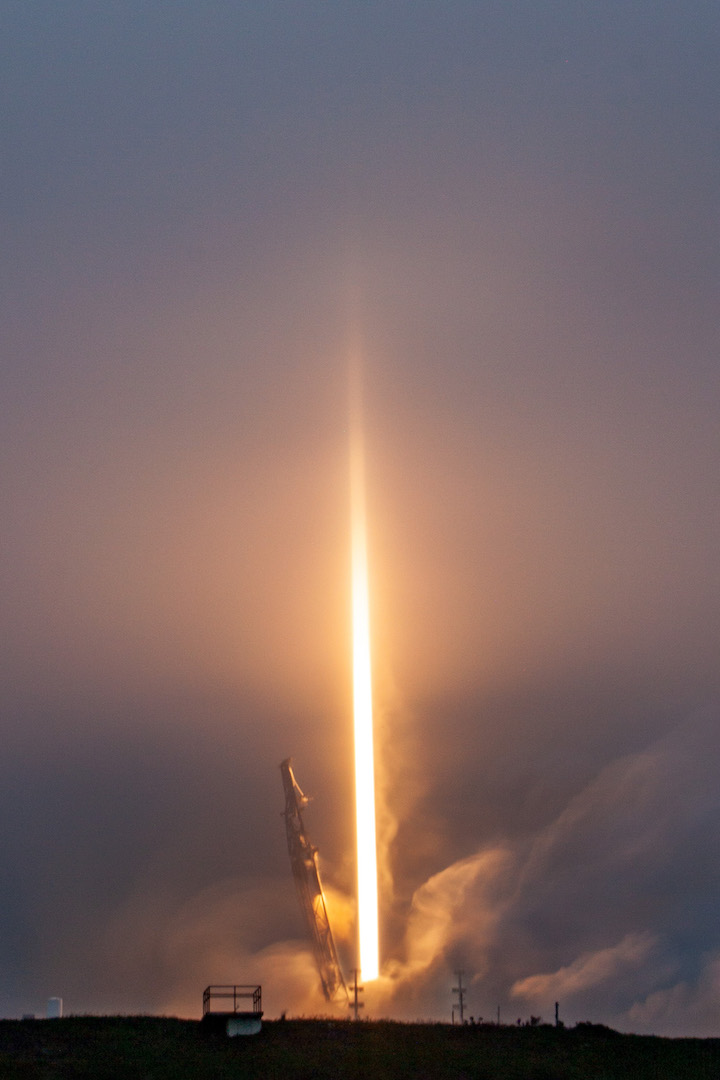SDA is Ready to Demonstrate PWSA Capabilities With the First Tranche 0 Launch

Falcon 9 launches the
Space Development Agency Tranche 0 mission to LEO on April 2. Photo: SpaceX
The Space Development Agency (SDA) saw the successful first launch for its proliferated Low-Earth Orbit (LEO) constellation this weekend. This was a highly anticipated launch as Tranche 0 demonstrates the feasibility of a proliferated constellation architecture for beyond line of sight targeting and advanced missile detection and tracking. SpaceX launched the first 10 satellites of Tranche 0 Sunday morning on a Falcon 9 mission from Vandenberg Space Force Base in California.
This first group of Proliferated Warfighter Space Architecture (PWSA) satellites goes up just four years after the SDA was stood up. The SDA plans to launch tranches, or spirals, every two years, and has awarded contracts for future tranches of the PWSA.
“This is the first dedicated SDA launch … and it’s the first launch of the Proliferative Warfighter Space Architecture,” SDA Director Derek Tournear said on a March 29 call with reporters. “We’re right at two-and-a-half years from order to orbit. We’re pretty excited to show that the model actually does work to be able to do proliferation to get capabilities to the warfighter at speed.”
The mission launched eight satellites built by York Space Systems: five space vehicles equipped with two optical communications terminals each & radio frequency (RF) receive/transmit capability; and three space vehicles that also have tactical data link (TDL) receive/transmit capability. These satellites are part of the Transport layer, for data transmission.
It also included two space vehicles built by SpaceX equipped with Wide Field of View (WFOV) sensor payload and two optical communication terminals each. These are part of the Tracking layer for missile warning and tracking.
Each space vehicle cost approximately $15 million, according to the SDA.
Tranche 0 will demonstrate the core architecture that will inform future tranches of the constellation, said Mike Eppolito, Tranche 0 program director.
“The intent is to get them in the warfighters’ hands so they can start developing their techniques to be able to use them. To give them the timeline to go through their training and to allow them to start thinking about how they would use the larger constellation once we have it on orbit,” Eppolito said on the March 29 call. “Ours is intended to be the demonstration tranche that allows them to get their feet wet and start using the capabilities that we’re putting on orbit.”
SDA confirmed after the launch on April 2 that it was successful.
The mission was set to go up on a Falcon 9 rocket on March 30, but there was an auto-abort in the countdown, and then SpaceX stood down from a second launch opportunity on March 31 to give more time for vehicle preparations.
Post-launch, the SDA plans to begin on-orbit demonstrations starting this summer. Tournear said that the Tracking satellites will participate in test events to demonstrate the tracking capabilities in spring of 2024.
For the Transport layer, there will be a number of lower level exercise with warfighters, primarily on the Link 16 side, Tournear said. “We’ll start out with tests at Eglin [Air Force Base] testing training facility to demonstrate that and really iron out all the bugs and figure out exactly how to do this kind of connectivity with terrestrial Link 16 radios in space. Then we’ll start to start to participate in some other exercises in the INDOPACOM [U.S. Indo-Pacific Command] region after that, primarily working with the Marines and some of their planned exercises,” he said.
This first launch slipped from September 2022 to December 2022, then to March. Technical issues included software, radios, and a shortage of microelectronic components. With the schedule slip, the satellites will not be able to participate in the U.S. Indo-Pacific Command’s Northern Edge exercise in Alaska this summer, as previously planned.
A second Tranche 0 launch is planned for June of this year. At this time, that mission is expected to deploy 18 satellites from contractors York Space Systems, Lockheed Martin, SpaceX, and L3Harris. The manifest will be confirmed about a month out from launch.
Read more: Industry leaders recently spoke with Via Satellite about the PWSA has disrupted government contracting and energized demand for manufacturing.